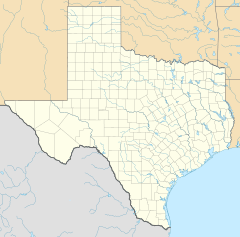Manchaca, Texas facts for kids
Quick facts for kids
Manchaca
|
|
|---|---|

Manchaca Post Office
|
|
| Country | United States |
| State | Texas |
| County | Travis |
| Area | |
| • Total | 1.9 sq mi (4.9 km2) |
| • Land | 1.9 sq mi (4.9 km2) |
| • Water | 0.0 sq mi (0.0 km2) |
| Population
(2020)
|
|
| • Total | 2,266 |
| • Density | 1,190/sq mi (462/km2) |
| Time zone | UTC-6 (Central (CST)) |
| • Summer (DST) | UTC-5 (CDT) |
| ZIP codes |
78652
|
Manchaca (pronounced MAN-shak) is a small community in Travis County, Texas, United States. It is a "census-designated place" (CDP), which means it's a community that the government counts for the census, but it's not officially a city or town. Manchaca is located about 10 miles southwest of downtown Austin. In the 2020 census, 2,266 people lived here.
Contents
Where is Manchaca Located?
Manchaca is found at coordinates 30.135304 degrees North and -97.836263 degrees West. The community covers a total area of about 1.9 square miles (4.9 square kilometers), and all of this area is land.
How Many People Live in Manchaca?
| Historical population | |||
|---|---|---|---|
| Census | Pop. | %± | |
| 2010 | 1,133 | — | |
| 2020 | 2,266 | 100.0% | |
| U.S. Decennial Census 1850–1900 1910 1920 1930 1940 1950 1960 1970 1980 1990 2000 2010 |
|||
The number of people living in Manchaca has grown over time. In 2010, the population was 1,133. By 2020, it had doubled to 2,266 people.
Schools in Manchaca
Students in Manchaca attend schools within the Austin Independent School District.
- Elementary School: Most younger students go to Menchaca Elementary School, which is located right in the Manchaca community. This school was built in 1977.
- Middle School: Older students attend Paredes Middle School in Austin. This middle school opened in January 2000.
- High School: For high school, students go to Akins High School in Austin. Akins High School welcomed its first students in August 2000.
Getting Around Manchaca: Roads and Transportation
Several important roads pass through Manchaca, helping people travel to and from the community.
- Texas Farm-to-Market Road 1626: This road generally runs from west to east. It connects to Interstate 35 about two miles to the east.
- Texas Farm-to-Market Road 2304: This road is also known as Manchaca Road in the southern part of the community. As it goes into Austin, its name changes to Menchaca Road. This change happened in 2019 to honor Jose Antonio Menchaca, a Texas Revolution army officer.
- Twin Creeks Road: This road runs south from FM 1626.
- Old San Antonio Road: This historic road runs south from Austin towards Buda. It passes near Manchaca Springs, which is an important historical spot.
Manchaca's History
Manchaca's early history is closely tied to the natural springs in the area. These springs, known as Manchaca Springs, were a popular stopping point along old travel routes like the Old San Antonio Road and the Chisholm Trail.
What's in a Name?
There are different ideas about where the name "Manchaca" came from.
- One idea is that it comes from a Choctaw word, imashaka, meaning "behind it."
- Another idea is that Manchaca Springs was named after Tejano army officer José Antonio Menchaca. The way "Manchaca" is pronounced today is simply how English speakers changed the original sound.
Early writings and maps show different spellings for the springs, such as "Manshack Springs" and "Manjack's Springs." Maps from 1849 show the spelling "Manchac Springs."
Early Settlements and Growth
One of the first owners of Manchaca Springs was Washington D. Miller. He was an important person in the Republic of Texas government. The first post office in the area, called Manchac House, opened in 1851 but closed the next year.
In 1852, Adolphus Weir bought the springs and ran a stagecoach stop there. His family owned land in the area for many years.
The community started to grow more when the International-Great Northern Railroad opened in 1880. A third post office, named Manchaca, opened then. By 1884, about 75 people lived in Manchaca, and it was a place where cotton, grain, and lumber were shipped.
In the 1890s, a Methodist church, a hotel, and a school opened. By 1903, Manchaca had 100 people and four businesses, including a general store and a cotton gin. The population grew to 200 by the 1960s. After a dip in the 1970s, the community began to grow again in the mid-1980s and early 2000s.
Manchaca's Climate
Manchaca has a climate with hot, humid summers and generally mild to cool winters. This type of weather is known as a humid subtropical climate.
See also
 In Spanish: Manchaca (Texas) para niños
In Spanish: Manchaca (Texas) para niños




